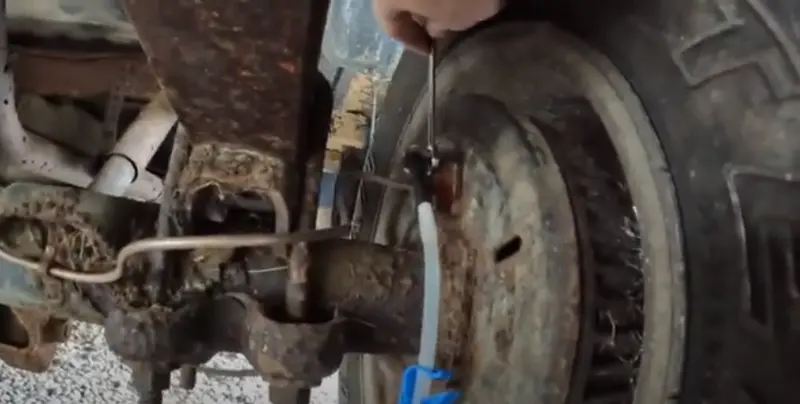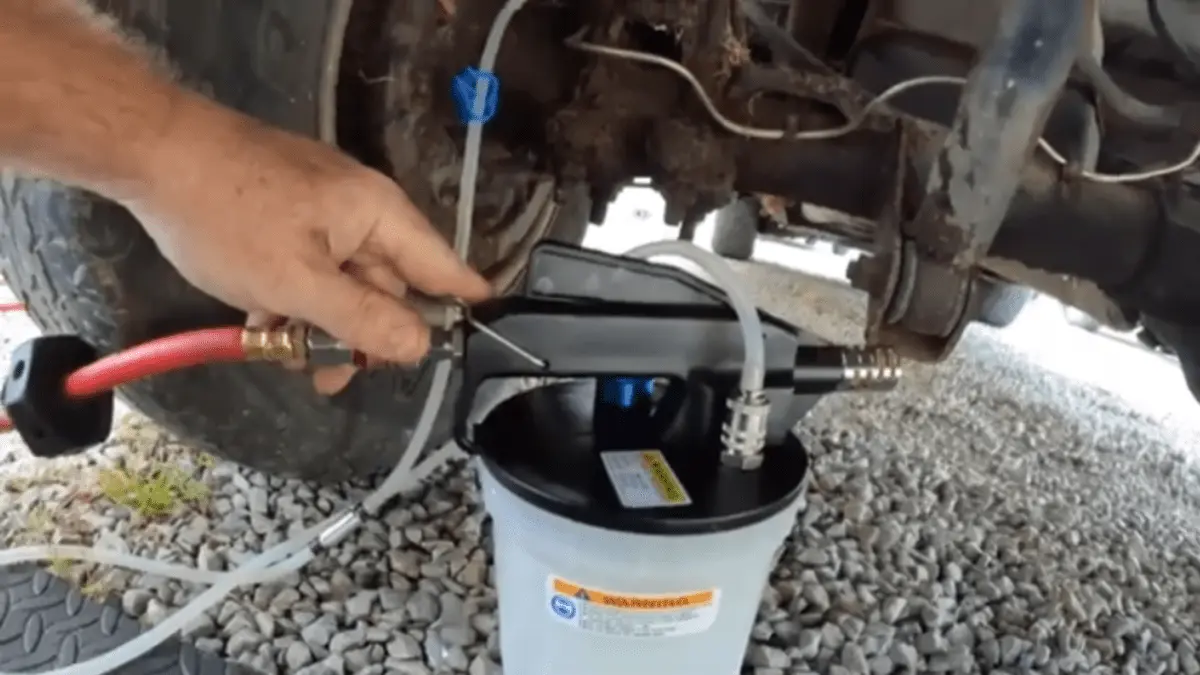Your Chevy Silverado’s braking system is a crucial component ensuring your safety on the road. However, even the most robust systems require regular maintenance, including brake bleeding, to operate optimally. So, what can be some Chevy Silverado brake bleeding problems?
Common Chevy Silverado brake bleeding problems include air in the brake lines, uneven brake pad wear, brake fluid contamination, damage to bleeder valves, and issues with bleeding the anti-lock brake system (ABS). These problems can reduce braking performance and safety concerns if not addressed promptly.
In this blog post, we delve into the common brake bleeding problems that Silverado owners often encounter, such as air in the brake lines, uneven pad wear, and brake fluid contamination.
Common Chevy Silverado Brake Bleeding Problems

Brake bleeding is an essential maintenance task for your Chevy Silverado to ensure proper brake system function. However, it can sometimes be a challenging process, and there are a few common problems that Silverado owners may encounter:
- Air in the Brake Lines: The most common problem during brake bleeding is the presence of air bubbles in the brake lines. Air can enter the system through various means, such as a leak or improper bleeding technique. When air is trapped in the brake lines, it can cause a soft or spongy brake pedal and reduced braking efficiency.
- Uneven Brake Pad Wear: If the brake calipers are not correctly bled, it can result in uneven brake pad wear. This means that some brake pads may wear out faster than others, leading to decreased braking performance and the need for premature brake pad replacement.
- Brake Fluid Contamination: Contaminated brake fluid can also be problematic during brake bleeding. Brake fluid can become contaminated with moisture, debris, or other contaminants, leading to a decrease in brake system performance. It’s essential to use clean, fresh brake fluid and to seal the brake system effectively to prevent contamination during the bleeding process.
- Bleeder Valve Damage: The bleeder valves on the brake calipers are susceptible to damage if not handled carefully. Over-tightening or cross-threading the bleeder valves can result in leaks and difficulty during the bleeding process. Using the proper tools and caring when working with the bleeder valves can help prevent this issue.
- Inadequate Bleeding Technique: Bleeding the brake system correctly is crucial, and an inadequate bleeding technique can lead to persistent problems. Follow the recommended bleeding sequence for your Silverado model and use the proper bleeding equipment, such as a brake bleeder kit or a partner to help pump the brake pedal.
- ABS System Bleeding: Some Chevy Silverado models with anti-lock brake systems (ABS) require additional steps to bleed the ABS module properly. Failing to address the ABS during the bleeding process can result in improper brake function and the persistence of air in the lines.
How To Avoid It
To avoid common brake bleeding problems when working on your Chevy Silverado, follow these essential tips and steps to ensure a smooth and effective brake bleeding process:
Use the Right Tools:
Ensure you have the necessary tools, such as a brake bleeder kit, a box-end wrench, and a clear plastic hose. Using the correct tools will make the process more manageable and reduce the risk of damage to the bleeder valves.
Refer to the Service Manual:
Always consult your Chevy Silverado’s service manual for specific bleeding procedures, recommended brake fluid type, and the correct sequence for bleeding the brakes. Different Silverado models may have varying bleeding requirements, so following the manual is crucial.
Start with Clean Brake Fluid:
Use fresh, clean brake fluid from a sealed container. Brake fluid is hygroscopic, meaning it absorbs moisture over time, which can lead to brake system contamination. Contaminated fluid can reduce braking performance and damage to the brake components.
Bleed in the Correct Sequence:
Follow the recommended sequence for bleeding your Silverado’s brakes. Typically, start with the brake farthest from the master cylinder (usually the rear passenger side) and work your way towards the nearest (usually the front driver-side). This ensures that all air is expelled from the system.
Ensure Proper Bleeder Valve Care:
When working with bleeder valves, be gentle. Do not over-tighten or cross-thread them, which can lead to leaks and damage. Clean the bleeder valves before opening them to prevent debris from entering the brake system.
Use the Two-Person Method:
Brake bleeding is often more accessible and effective when done with a helper. One person can operate the brake pedal while the other opens and closes the bleeder valve. This method ensures that air is effectively expelled from the brake lines.
Bleed the ABS System (if equipped):
Some Silverado models have anti-lock brake systems (ABS) that require special bleeding procedures. Consult your service manual for the correct steps to bleed the ABS module. Neglecting the ABS can lead to persistent air in the lines and improper brake function.
Perform a Final Check:
After bleeding all the brakes, do a final check to ensure there are no leaks, the brake pedal is firm, and there is no sponginess. Test the brakes in a safe area to confirm they are functioning correctly.
Regular Maintenance:
Brake bleeding is just one part of brake system maintenance. Regularly inspect your brake components for signs of wear, such as pad thickness, caliper condition, and brake line integrity. Keeping your brake system in good shape can prevent issues in the first place.
ABS Bleeding Procedures For Chevy Silverado
Bleeding the anti-lock brake system (ABS) on a Chevy Silverado is a crucial step to ensure the proper functioning of the brakes. The ABS should be bled after bleeding the individual brake calipers. Below are the general steps for bleeding the ABS on a Chevy Silverado:
1. Preparation:
- Park the vehicle on a level surface and engage the parking brake.
- Ensure the ignition is turned off.
- Disconnect the vehicle’s battery to prevent accidental activation of the ABS.
2. Locate the ABS Bleeder Valves:
- Locate the ABS bleeder valves, which are typically found on the ABS hydraulic control unit. This unit is often under the hood, near the brake master cylinder.
3. Clear Debris:
- Clean the area around the ABS bleeder valves to prevent debris from entering the system during the bleeding process.
4. Connect a Brake Bleeder Kit:
- Attach a brake bleeder kit to the ABS bleeder valves. These kits usually have a hose and a container to collect the old brake fluid.
5. Refill the Master Cylinder:
- Ensure the brake master cylinder is filled with the appropriate brake fluid specified in your service manual.
6. Bleeding Procedure:
- With the brake bleeder kit attached, have an assistant sit in the driver’s seat to operate the brake pedal.
- Open the first ABS bleeder valve slightly.
- Instruct the assistant to press the brake pedal slowly and steadily, allowing brake fluid to flow through the hose.
- Close the bleeder valve while the brake pedal is still depressed.
- Release the brake pedal slowly.
- Repeat this process for each ABS bleeder valve, starting with the valve farthest from the master cylinder and working to the nearest valve.
7. Check the Fluid Level:
- Periodically check and refill the brake master cylinder with fresh brake fluid to prevent air from entering the system.
8. Repeat the Process:
- You may need to repeat the bleeding process multiple times until you are confident that all air has been removed from the ABS.
9. Close and Seal Valves:
- Once you are satisfied that the ABS is adequately bled, close and seal the ABS bleeder valves tightly.
10. Reconnect the Battery:
- Reconnect the vehicle’s battery and ensure all connections are secure.
11. Perform a Test Drive:
- Take the vehicle for a test drive to verify that the ABS functions correctly and that the brake pedal feels firm and responsive.
FAQs
1. What Causes A Soft Or Spongy Brake Pedal After Bleeding My Chevy Silverado’s Brakes?
A soft or spongy brake pedal is often the result of air trapped in the brake lines. To resolve this issue, re-ble the brake system and ensure all air bubbles are removed.
2. How Can I Prevent Brake Fluid Contamination During The Bleeding Process?
To prevent brake fluid contamination, always use clean, sealed brake fluid from a reputable source. Seal the brake system effectively and avoid introducing contaminants during the bleeding process.
3. What Are The Signs Of A Damaged Bleeder Valve, And How Can I Avoid It?
Damaged bleeder valves can result in leaks and difficulties during bleeding. Signs of damage include stripped threads or visible leaks. To avoid this, use the proper tools and exercise care when working with bleeder valves.
4. What Should I Do If I Encounter Persistent Brake Bleeding Problems?
If you encounter persistent issues, it’s advisable to seek professional assistance from a certified mechanic or service center. They can diagnose and address any underlying problems in the brake system.
5. How Often Should I Bleed The Brakes On My Chevy Silverado?
The frequency of brake bleeding depends on factors like your driving habits and the condition of your brake system. Typically, it’s recommended to bleed the brakes every 2-3 years or as needed when you notice brake performance issues.
Final Words
Brake bleeding is a critical maintenance task for your Chevy Silverado, essential for maintaining safe and effective braking performance. Common issues such as air in the brake lines, uneven pad wear, and brake fluid contamination can be addressed by following proper bleeding techniques, using the right tools, and consulting your vehicle’s service manual. Regular maintenance, including brake system inspection and bleeding when necessary, is key to preserving the longevity and reliability of your Silverado’s braking system. If you encounter persistent problems or lack confidence in your abilities, seeking professional help is a wise choice to ensure your vehicle’s safety.

Eric L. Friedman is a car expert who has worked on Chevy and GMC trucks for over 10 years. He started AutoYolo to help people fix their own cars. On the blog, he shares easy tips, step-by-step guides, and repair advice to make car problems less stressful and more affordable.

